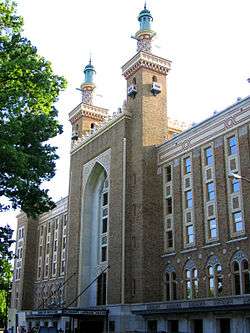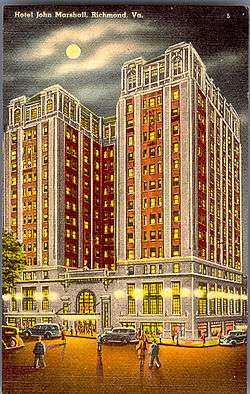Marcellus E. Wright Sr.
| Marcellus Eugene Wright Sr. | |
|---|---|
| Born |
April 8, 1881 Hanover County, Virginia |
| Died |
December 8, 1962 (aged 81) Richmond, Virginia |
| Nationality | American |
| Occupation | Architect |
| Spouse(s) | Ritta Stovall |
| Children | Marcellus Eugene Wright Jr., Frances Wright |
| Parent(s) | A. W. Wright, Isebella Wright |
| Buildings | Altria Theater, The Chamberlin, Hotel John Marshall |
| Projects | Colonial Williamsburg |
Marcellus Eugene Wright Sr. (April 8, 1881 – December 8, 1962) was an American architect. He was active in Richmond, Virginia and the surrounding region during the first half of the 20th century. In addition to his work on hotels, Wright was a pioneer of the Moorish Revival architectural style in his design for the Altria Theater (formerly known as the Mosque), which is a key component of the Monroe Park Historic District.[1]
Personal life
Marcellus E. Wright was born on April 8, 1881, in Hanover County, Virginia, the son of A. W. Wright and Isebella Wright.[2][note 1]
In 1906, Marcellus Wright married Ritta Stovall at a ceremony which took place in Henrico County, Virginia. The marriage resulted in two children: Marcellus E. Wright Jr. and Frances Wright.[6] They lived for years in Richmond with two of Wright's sisters-in-law and at least one boarder.[7][8][9] Wright died on December 8, 1962, of what were reported to be natural causes, and is buried in Hollywood Cemetery.[10][11]
Multiple members of the Wright family went on to make a name for themselves in architecture. Marcellus E. Wright Jr. would join his father's firm of Marcellus Wright & Son, and later became a leading light of Virginia architecture as member of Marcellus Wright Cox & Smith.[12][13] Oscar Pendleton Wright, brother to the senior Wright, entered into partnership with noted Richmond firm Carneal & Johnston, where he worked on St. Joseph's Villa.[14]
During his life, Marcellus Wright Sr. served as an active member of the Sons of the American Revolution, and from 1939-1940 was President of its Richmond Chapter.[15] He was also a Freemason, having attained the thirty-second degree in the Scottish Rite.[16]
Career
At the age of sixteen, Wright began work for Richmond architecture firm Noland & Baskervill, where he stayed for five years before moving to the Philadelphia firm Cope & Stewardson. He took courses in architecture at the Philadelphia School of Applied Art and the University of Pennsylvania, the latter of which he graduated from in 1905.[16][17] After graduating, Wright swiftly rose to prominence in the Richmond architecture scene; he was one of the eleven founding members of the Richmond Association of Architects, which was established in 1911.[18] By 1922, he had attained sufficient stature to have been elected a member of the American Institute of Architects.[19]
In April 1925, a collaboration between Marcellus Wright, Paul Philippe Cret, and Berthold Nebel produced the winning entry for a contest to design the Virginia War Memorial. Construction proceeded to the point of laying foundations before the project was scrapped. A carillon designed by Ralph Adams Cram was erected in its stead.[20]
Through the 1930s, Wright served on the Architectural Advisory Committee which presided over the Colonial Williamsburg restoration.[21]
Local architect Beth Nickels was hired to join Wright's firm in 1947 as a draftsman and project manager. Nickels was recognized by the Times-Dispatch as the first female architect from Richmond and one of the first from Virginia.[12]
Selected works


Marcellus Wright's works include:
- The Altria Theater (1925), dedicated originally for use by the Shriners and operated as the Acca Temple Shrine; due to its multiple minarets and domes the building was known for years as "the Mosque." It was designed in partnership with fellow Virginia architect Charles M. Robinson. In consideration for listing by the National Register of Historic Places, the Mosque was described as "an architectural fantasy on Moorish themes...a perfect example of turn-of-the-century American eclecticism."[1]
- The William Byrd Hotel (1925), the first hotel designed by Marcellus E. Wright. Located across from Broad Street Station, the William Byrd Hotel was described by the Richmond News Leader as "a monument to Richmond energy, talent, and progressiveness." In 1996, the former hotel was reopened as an apartment building.[22]
- The Wright Pavilion (1927), a part of the Blue Ridge Sanatorium which was sponsored by the Grand Lodge of Virginia and named in honor of Masonic leader George C. Wright. With capacity for sixty beds, the Pavilion was built to aid treatment of tuberculosis as part of the state-run tuberculosis sanatorium. In exchange for funding, members of the Grand Lodge obtained preference in admittance to the state-run facility, and any major changes had to seek Grand Lodge approval. This project marked Wright's second major collaboration with Charles M. Robinson, as Robinson was responsible for the Sanatorium's initial planning.[23]
- The Chamberlin (1928), formerly known as the Chamberlin Hotel and originally as the Chamberlin-Vanderbilt Hotel due to financial backing from the Vanderbilt family. Designed in the Beaux-Arts style and opened as a luxury resort on the Chesapeake Bay, the building is now in use as a retirement home catering to U.S. veterans.[24]
- The Hotel John Marshall (1929), an upscale fixture of downtown Richmond. Its main U-shaped structure originally was topped by a terracotta cornice, and rests upon a three-story limestone base.[25] Since 2011, the former hotel has completed renovations and now functions as luxury apartments. Gubernatorial election festivities were held at the Hotel John Marshall by Virginia Governors-Elect Linwood Holton and Douglas Wilder. On other occasions, the hotel played host to multiple Presidents of the United States, including Franklin Roosevelt, Harry Truman, Dwight D. Eisenhower, Richard Nixon, Gerald Ford, Jimmy Carter, and Ronald Reagan.[26]
- Lunenburg's Old County Courthouse (1939), originally built in 1827, modified and expanded by Marcellus Wright. The external stairs of the building are the most visible extant portion of Wright's expansion.[27]
- The Terminal Building of Richmond International Airport (1950), which at the time was still named after Virginia aviator Richard E. Byrd.[28]
Notes
- ↑ While Wright's publicly available birth records and his entry in the Social Security Death Index[3] list his birth date as April 8, both of his draft registration cards for World War I and World War II record him as having been born on April 5.[4][5]
References
- 1 2 "Monroe Park Historic District National Register Nomination" (PDF). Virginia Department of Historic Resources. Retrieved January 14, 2017.
- ↑ "Virginia Births and Christenings, 1584-1917", FamilySearch, Marcellus E Wright, 08 Apr 1881; citing Hanover, Virginia, reference 303; FHL microfilm 2,046,938.
- ↑ "United States Social Security Death Index", FamilySearch, Marcellus Wright, Jan 1963; citing U.S. Social Security Administration, Death Master File, (Alexandria, Virginia: National Technical Information Service, ongoing).
- ↑ "United States World War I Draft Registration Cards, 1917-1918", FamilySearch, Marcellus Eugene Wright, 1917-1918; citing Richmond City no 5, Virginia, United States, NARA microfilm publication M1509 (Washington D.C.: National Archives and Records Administration, n.d.); FHL microfilm 1,985,173.
- ↑ "United States World War II Draft Registration Cards, 1942", FamilySearch, Marcellus Eugene Wright, 1942; citing NARA microfilm publication M1936, M1937, M1939, M1951, M1962, M1964, M1986, M2090, and M2097 (Washington D.C.: National Archives and Records Administration, n.d.).
- ↑ "Virginia Marriages, 1785-1940", FamilySearch, Marcellus E. Wright and Ritta B. Stovall, 31 Jan 1906; citing Henrico County, Virginia, reference Image 254; FHL microfilm 2,048,456.
- ↑ "Marcellus E. Wright", United States Census, 1920; Richmond Clay Ward, Richmond, Virginia; roll T625 1909, page 4A, line 3, enumeration district 78, Family History film 1821909. Retrieved on January 14, 2017.
- ↑ "Marcellus E. Wright", United States Census, 1930; Richmond, Virginia; roll T626 2477, page 10B, line 56, enumeration district 38, Family History film 2342211. Retrieved on January 14, 2017.
- ↑ "Marcellus E. Wright", United States Census, 1940; Lee Ward, Richmond, Virginia; roll T627 4324, page 13A, line 19, enumeration district 118-157, Family History film 005449116. Retrieved on January 14, 2017.
- ↑ Shuck, John (March 24, 2012). "Marcellus E. Wright". Find a Grave. Retrieved January 14, 2017.
- ↑ "Marcellus Wright, Noted Richmond Architect, Dies". The Bee. Danville, Virginia. Associated Press. December 8, 1962. Retrieved January 14, 2017. (Subscription required (help)).
- 1 2 Robertson, Ellen (April 15, 2012). "Beth Nickels, first female architect in Richmond, dies at 93". Richmond Times-Dispatch. Retrieved January 14, 2017.
- ↑ Slipek, Edwin (April 3, 2002). "Marcellus Eugene Wright Jr. [Obit]". Style Weekly. Richmond. Retrieved January 14, 2017.
- ↑ Winthrop, Robert P. (November 14, 2013). "Architects of Richmond: Carneal & Johnston". ArchitectureRichmond. Retrieved January 14, 2017.
Oscar Pendleton Wright, Marcellus Wright’s brother, was a partner in the Carneal firm at his time and he lists the Villa as his project.
- ↑ "Our History". Richmond Chapter, Virginia Society, Sons of the American Revolution. 2014. Retrieved January 14, 2017.
- 1 2 Brownell, Charles E. (1992). The Making of Virginia Architecture. Richmond, VA: Virginia Museum of Fine Arts. p. 360. ISBN 0-917046-34-X.
- ↑ Kollatz, Harry (March 2012). "A Grand Lady's Revival: The Hotel John Marshall's landmark sign rejoins the skyline" (PDF). Richmond Magazine. Retrieved January 14, 2017.
Richmond architect Marcellus E. Wright’s design resonated big-city sophistication. In the Marshall, he distilled his studies at the Philadelphia School of Applied Art and experiences in a dozen European countries.
- ↑ Brownell, Charles E. (1992). The Making of Virginia Architecture. Richmond, VA: Virginia Museum of Fine Arts. p. 91. ISBN 0-917046-34-X.
- ↑ "New Members Elected". Journal of the American Institute of Architects. 10 (6): 208. June 1922. Retrieved January 14, 2017.
- ↑ Harbeson, John (December 1966). "Paul Cret and Architectural Competitions". Journal of the Society of Architectural Historians. 25 (4): 305. JSTOR 988361. doi:10.2307/988361.
- ↑ McDonald, Travis C. (2006–2007). "The Fundamental Practice of Fieldwork at Colonial Williamsburg". Perspectives in Vernacular Architecture. 13 (2): 39. JSTOR 20355382.
- ↑ Virginia Department of Historic Resources (1999). Loth, Calder, ed. The Virginia Landmarks Register (4th ed.). University of Virginia Press. p. 430. ISBN 0-8139-1862-6.
- ↑ Sucre, Richard. "The Early Institutionalization of Blue Ridge Sanatorium and the George W. Wright Pavilion". Blue Ridge Tuberculosis Sanatorium. University of Virginia. Retrieved January 14, 2017.
- ↑ "Chamberlin Hotel National Register Nomination" (PDF). Virginia Department of Historic Resources. Retrieved January 15, 2017.
- ↑ Wilson, Richard Guy, ed. (2002). Buildings of Virginia: Tidewater and Piedmont. Oxford University Press. p. 220. ISBN 0-19-515206-9.
- ↑ Kollatz, Harry (March 2012). "A Grand Lady's Revival: The Hotel John Marshall's landmark sign rejoins the skyline" (PDF). Richmond Magazine. Retrieved January 14, 2017.
- ↑ "Lunenburg County". US Courthouses. Retrieved January 15, 2017.
The building was enlarged in 1939 and the exterior stairs added. The architect was Marcellus E. Wright Sr. of Richmond.
- ↑ "Terminal Building, Richard E. Byrd Airport, Richmond, Virginia". Rarely Seen Richmond. Virginia Commonwealth University. 1959. Retrieved January 15, 2017.